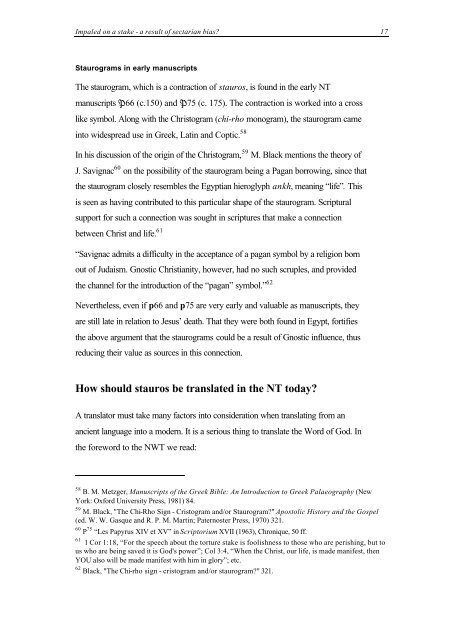Impaled on a stake — a result of sectarian bias?
You also want an ePaper? Increase the reach of your titles
YUMPU automatically turns print PDFs into web optimized ePapers that Google loves.
<str<strong>on</strong>g>Impaled</str<strong>on</strong>g> <strong>on</strong> a <strong>stake</strong> - a <strong>result</strong> <strong>of</strong> <strong>sectarian</strong> <strong>bias</strong>? 17<br />
Staurograms in early manuscripts<br />
The staurogram, which is a c<strong>on</strong>tracti<strong>on</strong> <strong>of</strong> stauros, is found in the early NT<br />
manuscripts ‰66 (c.150) and ‰75 (c. 175). The c<strong>on</strong>tracti<strong>on</strong> is worked into a cross<br />
like symbol. Al<strong>on</strong>g with the Christogram (chi-rho m<strong>on</strong>ogram), the staurogram came<br />
into widespread use in Greek, Latin and Coptic. 58<br />
In his discussi<strong>on</strong> <strong>of</strong> the origin <strong>of</strong> the Christogram, 59 M. Black menti<strong>on</strong>s the theory <strong>of</strong><br />
J. Savignac 60 <strong>on</strong> the possibility <strong>of</strong> the staurogram being a Pagan borrowing, since that<br />
the staurogram closely resembles the Egyptian hieroglyph ankh, meaning “life”. This<br />
is seen as having c<strong>on</strong>tributed to this particular shape <strong>of</strong> the staurogram. Scriptural<br />
support for such a c<strong>on</strong>necti<strong>on</strong> was sought in scriptures that make a c<strong>on</strong>necti<strong>on</strong><br />
between Christ and life. 61<br />
“Savignac admits a difficulty in the acceptance <strong>of</strong> a pagan symbol by a religi<strong>on</strong> born<br />
out <strong>of</strong> Judaism. Gnostic Christianity, however, had no such scruples, and provided<br />
the channel for the introducti<strong>on</strong> <strong>of</strong> the “pagan” symbol.” 62<br />
Nevertheless, even if p66 and p75 are very early and valuable as manuscripts, they<br />
are still late in relati<strong>on</strong> to Jesus’ death. That they were both found in Egypt, fortifies<br />
the above argument that the staurograms could be a <strong>result</strong> <strong>of</strong> Gnostic influence, thus<br />
reducing their value as sources in this c<strong>on</strong>necti<strong>on</strong>.<br />
How should stauros be translated in the NT today?<br />
A translator must take many factors into c<strong>on</strong>siderati<strong>on</strong> when translating from an<br />
ancient language into a modern. It is a serious thing to translate the Word <strong>of</strong> God. In<br />
the foreword to the NWT we read:<br />
58 B. M. Metzger, Manuscripts <strong>of</strong> the Greek Bible: An Introducti<strong>on</strong> to Greek Palaeography (New<br />
York: Oxford University Press, 1981) 84.<br />
59 M. Black, "The Chi-Rho Sign - Cristogram and/or Staurogram?" Apostolic History and the Gospel<br />
(ed. W. W. Gasque and R. P. M. Martin; Paternoster Press, 1970) 321.<br />
60 P 75 “Les Papyrus XIV et XV” in Scriptorium XVII (1963), Chr<strong>on</strong>ique, 50 ff.<br />
61 1 Cor 1:18, “For the speech about the torture <strong>stake</strong> is foolishness to those who are perishing, but to<br />
us who are being saved it is God's power”; Col 3:4, “When the Christ, our life, is made manifest, then<br />
YOU also will be made manifest with him in glory”; etc.<br />
62 Black, "The Chi-rho sign - cristogram and/or staurogram?" 321.



